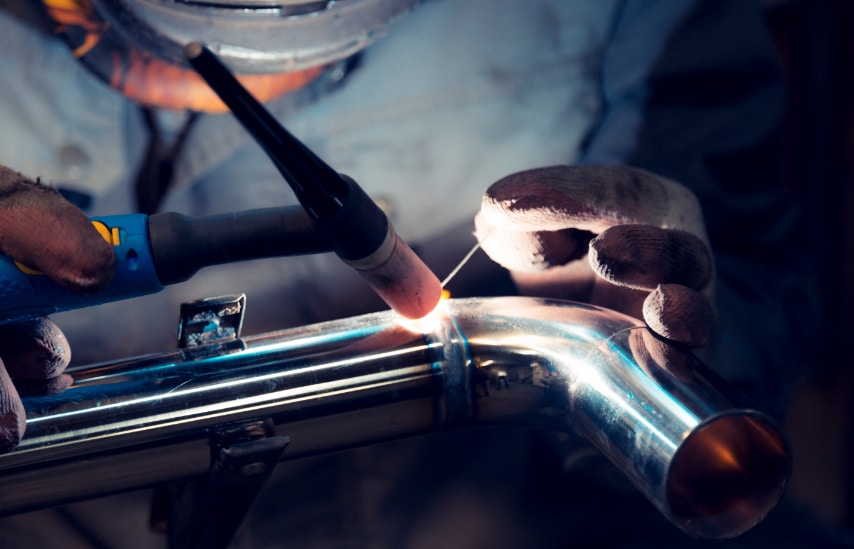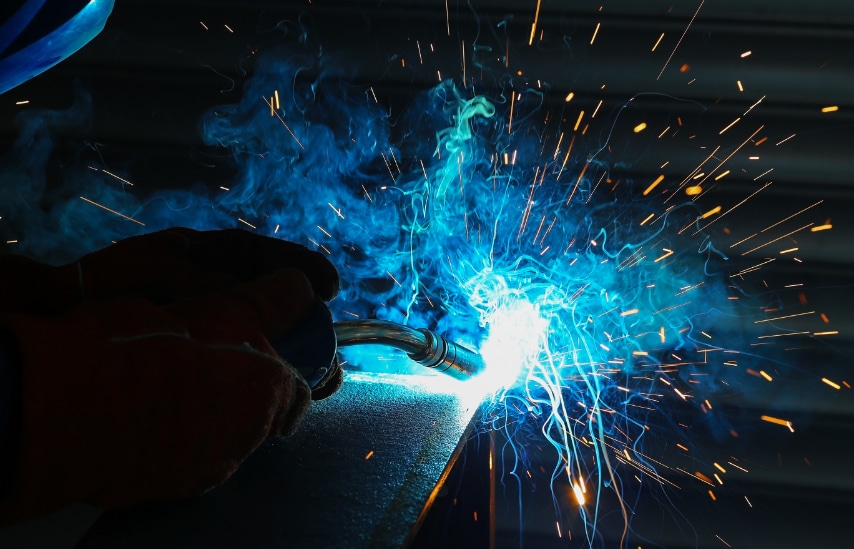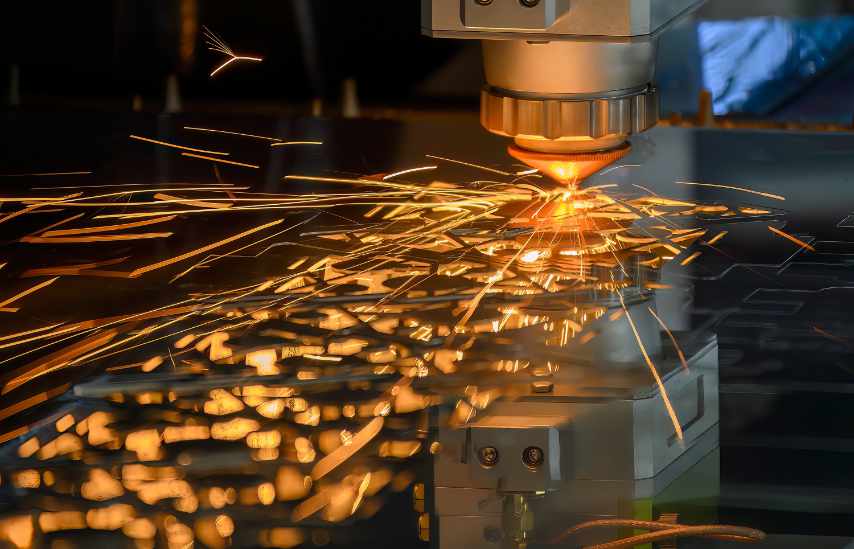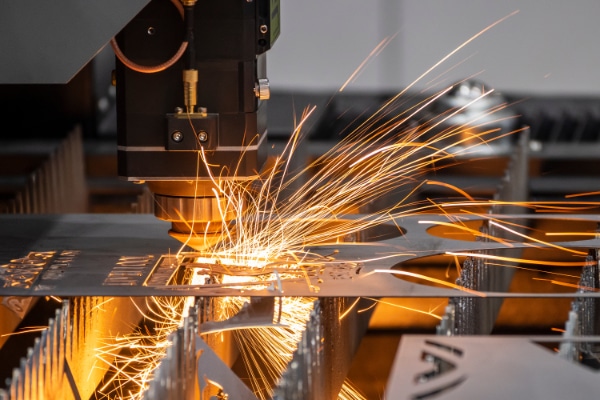Do you know which weld technique is most effective for your product?
A wide range of metallic materials can be welded, including stainless steel, steel, aluminium, titanium, copper and nickel. These materials can be welded by several methods, including Metal Inert Gas welding or Tungsten Inert Gas welding, also known as MIG and TIG, which are two of the most common weld techniques.
MIG Welding
Used to join two pieces of metal together, forming a strong weld seam, MIG welding is a common welding method for metals such as steel, aluminium, copper and nickel.
MIG Welding Definition
Metal Inert Gas welding is an arc welding process which involves the use of a continuous consumable wire electrode, meaning the wire is continuously fed through the welding gun. The electrode is melted when an electric arc is created between itself and the workpiece, forming the weld.
In MIG welding, a MIG torch or welding gun is used, alongside an automatic or semi-automatic wire feeder, power source and grounding cable, and a shielding gas tank.
MIG Welding Process
For a more in-depth look at how a MIG weld is created, we examine the MIG welding process.
During the MIG welding process, a continuous wire electrode acts as an anode whilst the workpiece acts as a cathode; this creates a short circuit and produces an electrical arc between the two materials, heating and melting the wire electrode. In MIG welding, the wire serves as both the heat source and the filler metal for the welding joint.
To protect the weld pool from contaminants, a shielding gas is fed alongside the electrode. This gas, which can be argon, oxygen, or carbon dioxide, depending on the metals being welded, forms an arc plasma, stabilises the arc roots, and ensures a smooth metal transfer.
MIG welding offers different metal transfer modes, including short-circuiting, droplet/spray, and pulsed, allowing for versatility in the welding process.
Pros and Cons of MIG Welding
MIG welding is a fast and relatively straightforward weld method, making it advantageous in many applications.
- High welding speed. MIG welding offers a high welding speed thanks to continuous wire feed, allowing you to complete projects quickly and efficiently. This makes it a great option for projects with a demanding timescale.
- Easy to learn and use for beginners. MIG welding is relatively easy to learn and use, making it a popular choice for beginners or those with limited welding experience.
- Quality weld. MIG welding produces a high-quality and clean weld, with minimal slag and reduced weld splattering.
However, there are some disadvantages to MIG welding, including…
- Limited in certain materials and positions. The nature of MIG welding means it is not suitable for tricky precision projects such as vertical or overhead welding.
- Unsuitable for thick metals over 25mm. MIG welding is not recommended for thick metals over 25mm, as it may struggle to penetrate and create a strong bond.
- Regular maintenance is important. Regular maintenance is also necessary to ensure the equipment functions properly and delivers consistent results. However, regular maintenance will not impact the manufacturing of your product, as machine maintenance is scheduled to avoid unexpected downtime.
TIG Welding
Tungsten Inert Gas Welding is another popular weld method for metals such as steel, aluminium, titanium, brass and more
Definition of TIG Welding
Unlike MIG, TIG welding utilises a non-consumable tungsten electrode to create precise and aesthetically pleasing welds. This welding process is often preferred for thinner materials or delicate jobs due to its high accuracy and aesthetic quality.
TIG welding requires the use of two hands and often a foot pedal for amperage control. The non-consumable tungsten electrode creates an electric arc that produces intense heat to melt the base metal while a separate filler rod is used to add material to the weld.
The equipment used in TIG welding also varies slightly from MIG – for starters, a wire feeder is not required to feed filler material. Equipment includes a welding torch, power source and grounding cable, and shielding gas tank.
TIG Welding Process
The TIG welding process works similarly to the MIG process – however there are some key differences to be explored.
TIG welding uses electricity to create an arc between a non-consumable tungsten electrode (the anode) and the metal being welded (the cathode). Unlike MIG welding, the tungsten electrode in TIG welding doesn't melt during the process. Instead, the arc melts the parent metal and a separate welding rod of filler metal, forming the weld bead.
The molten weld pool is protected by an inert shielding gas, typically argon or an argon mixture. To perform TIG welding, you need to coordinate the hand-held TIG torch with a filler rod, maintain the correct distance from the weld, and adjust the current, making it a complex process.
Pros and Cons of TIG Welding
Applications, where TIG welding may be chosen over MIG, are likely to prioritise:
- Precise and high quality welds. TIG welding offers precise and high-quality welds which are incredibly strong, making it ideal for jobs that require greater accuracy, aesthetic appeal and durability.
- Versatile for various materials and positions. It is also versatile and can be used on various materials (including refractory metals) and material thicknesses, as well as in different positions, allowing for in-situ joining.
However, there are some of the downfalls associated with TIG welding including:
- Time consuming and requires skill. TIG welding can be time-consuming due to the complexity of the process and requires a high level of skill and experience to perform. At Wrekin Sheetmetal, we continually invest in our team to ensure they have the skills they need to perform at the highest standard – so much so, we launched our own upskilling programme!
- Higher set up costs compared to MIG welding. The setup costs for TIG welding are higher compared to MIG welding, which can be a drawback for some.
MIG vs TIG Welding: The Key Differences
So, what are the key differences between MIG and TIG welding? Why would you choose one over the other?
Welding Techniques
TIG welding uses a non-consumable tungsten electrode and a separate filler rod, while MIG welding utilises a continuously-fed electrode wire and shielding gas. Because of this, the welding technique used for each method is also different.
Skill Level Required
This leads to another difference, which lies in the skill level required, as MIG welding is easier to learn and master than TIG welding, which demands more skill and experience.
Cost
In terms of cost, MIG welding machines and supplies are generally less expensive, but TIG welding costs more per foot of bead due to the additional prep work involved.
Weld Strength
When comparing MIG and TIG welding, the weld strength achieved with TIG welding is typically superior due to its better penetration capabilities. However, both MIG and TIG welding can achieve high levels of weld strength, depending on the application and the skill of the welder.
TIG welding allows for deeper weld penetration and is often considered for applications where precision and weld quality are critical. This enhanced strength and precision make TIG welding a preferred choice for critical applications where weld integrity is paramount, providing you with a sense of confidence and reliability in your welding projects.
Shielding Gas
Utilising the appropriate shielding gas plays an essential role in ensuring the quality and effectiveness of your welding process. In TIG welding, pure argon or gas blends are commonly used, while MIG welding relies on a mix of argon and carbon dioxide for better penetration.
Versatility
MIG welding demonstrates superior versatility compared to TIG welding across various metals and thicknesses. Its adaptability to different materials like aluminium, stainless steel, and mild steel makes it a versatile choice.
Whether you're working with thick or thin metals, MIG welding provides a reliable option for achieving quality welds. The ability to handle a wide range of materials gives you the confidence to tackle diverse welding projects effectively.
Speed
Speed plays an essential role in determining the efficiency and productivity of welding processes. MIG welding is faster than TIG welding, making it ideal for high-volume production where faster welding speeds are pivotal.
TIG welding, while slower, offers more precise control over the welding process. Understanding the trade-off between speed and control is key in choosing the right welding method for your project.
Additionally, TIG welding is also suitable for a wide range of materials, especially refractory materials which cannot be welded by MIG.
Ultimately, the choice between TIG and MIG welding depends on the specific project requirements, such as material, precision, weld position, project timescale, and more.
In conclusion, when it comes to choosing between MIG and TIG welding, it all depends on the specific needs of your project. Understanding the differences between MIG and TIG is the first step in deciding between welding methods.
Wrekin Sheetmetal’s expert welding team is on hand to offer our customers the advice they need to make the right decision for their fabrication project. We use tig and mig welding, get in touch now by filling out the contact form.
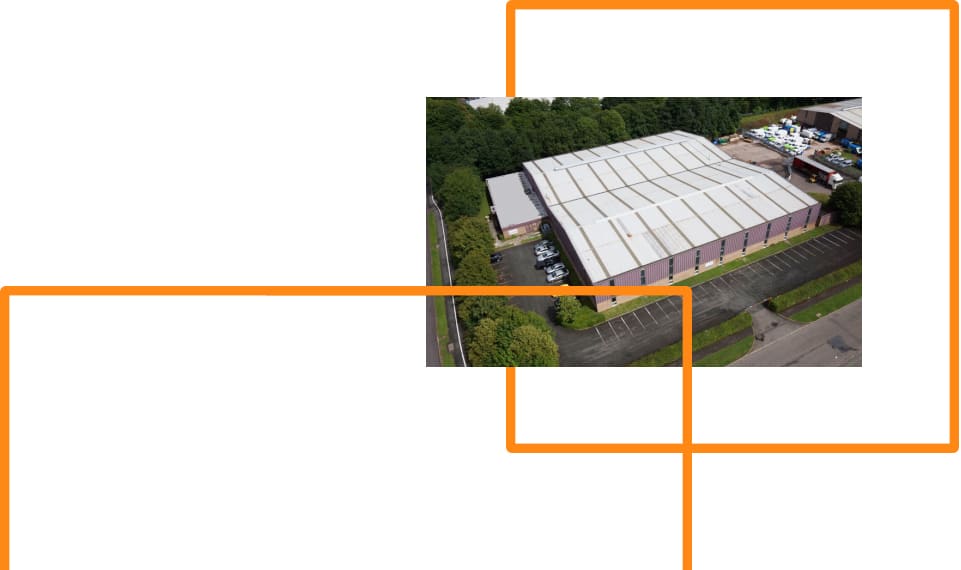
How can we help?
With over 17+ years of knowledge and experience, we’re confident we can offer a flexible solution beneficial to both parties, get in touch with us today.
